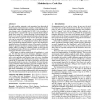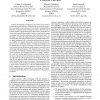479 search results - page 22 / 96 » A clustering technique to optimize hardware software synchro... |
POPL
2009
ACM
14 years 8 months ago
2009
ACM
We study modular, automatic code generation from hierarchical block diagrams with synchronous semantics. Such diagrams are the fundamental model behind widespread tools in the emb...
ISPASS
2007
IEEE
14 years 1 months ago
2007
IEEE
Address re-mapping techniques in so-called active memory systems have been shown to dramatically increase the performance of applications with poor cache and/or communication beha...
DSN
2002
IEEE
14 years 19 days ago
2002
IEEE
A virtual duplex system (VDS) can be used to increase safety without the use of structural redundancy on a single machine. If a deterministic program P is calculating a given func...
OSDI
1994
ACM
13 years 9 months ago
1994
ACM
A fine-grain parallel program is one in which processes are typically small, ranging from a few to a few hundred instructions. Fine-grain parallelism arises naturally in many situ...
ESEC
1999
Springer
13 years 12 months ago
1999
Springer
CIP is a model-based software development method for embedded systems. The problem of constructing an embedded system is decomposed into a functional and a connection problem. The ...



